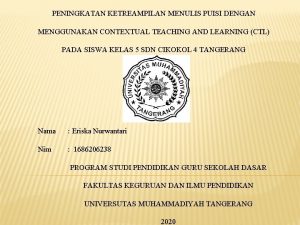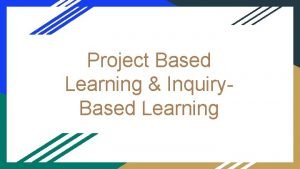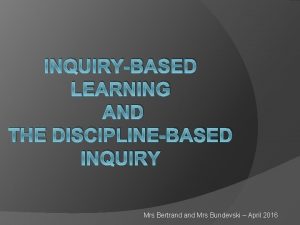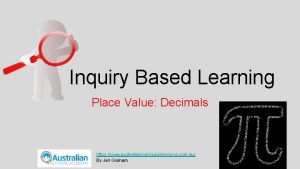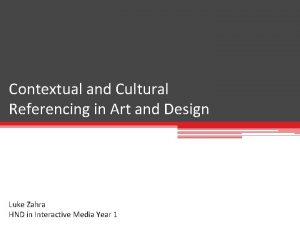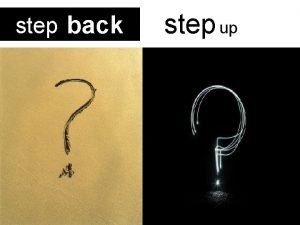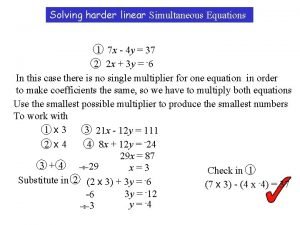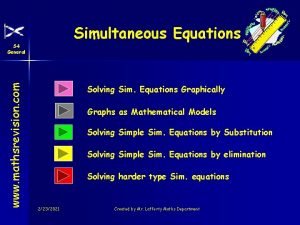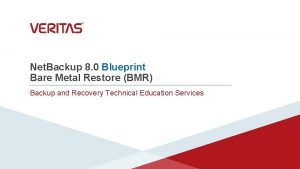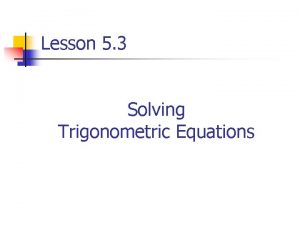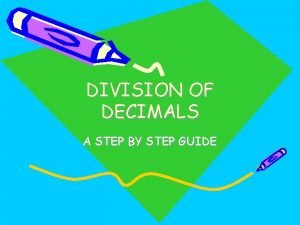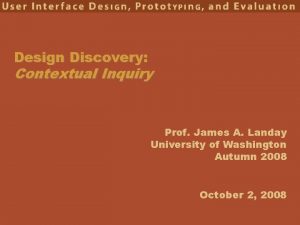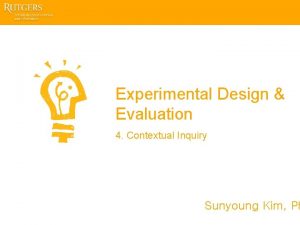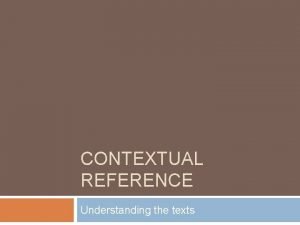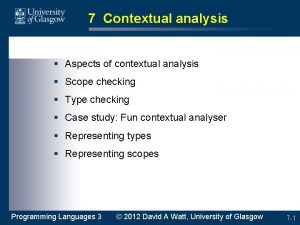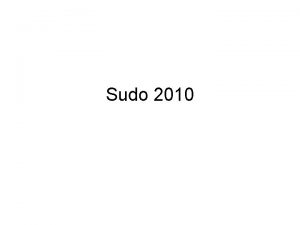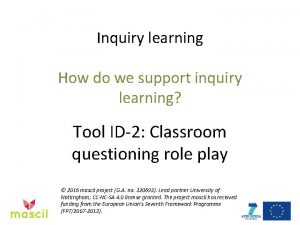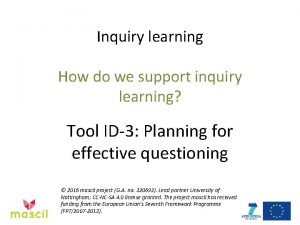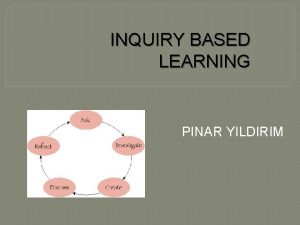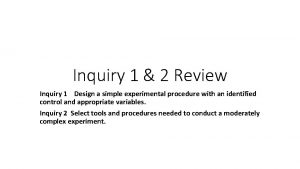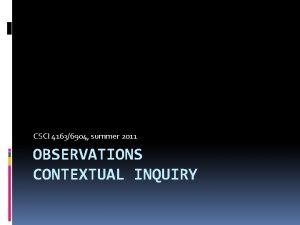First Step in Design Contextual Inquiry Learning what


































- Slides: 34


First Step in Design: Contextual Inquiry ü Learning what users do and what they care about: How do we find out how user’s think about stuff? . “Interaction design isn’t a matter of aesthetic choice, but rather it is based on an understanding of users and cognitive principles. ” Cooper, p. 11

ü My wysiwyg mental model of documents continues to give me problems: ü Does MS Power Point have a work model to fix this?

What is your mental model for turning on a shower? “You'll never guess how you turn on the shower! Frequently, when devices come with instructions stuck on them, there is a problem with the design. ” www. baddesigns. com

How do People reason about what they do? ü Reasoning requires a Knowledge Representation (KR) ü A Knowledge Representation Language (KRL) is a theory of Reasoning (cognition) • KRL = A data structure to encode facts + Methods for combining old facts to derive new facts • Examples : §Formal Logic §Neural Networks §Model-Based Reasoning

Mental Models ü The models people have of themselves, others, the environment, and the things with which they interact ü “Small-scale-model of External Reality” • • • Consider alternatives Try out situations Use knowledge of past events in dealing with the present and future

Structural and Functional Models ü Structural Models • • An internalized form of a system How many stop lights are between your house and the campus? ü Functional Models • • Internalized procedural knowledge of how a system works How do you look-up someone’s phone number in a phone book? ü We develop them through interacting with the world around us. • Curiosity

How do we use Mental Models? ü Predictive Power: Membantu problem solve dengan menyediakan kemampuan untuk memprediksi apa tindakan untuk menyelesaikan. ü Explanatory Power: Membantu belajar dengan menyediakan kemampuan untuk menjelaskan bagaimana peristiwa tertentu terjadi.


How do you eject a disk? “They gave the trashcan magical powers that are completely incompatible with the established metaphorical association of deleting files. As a result, new users express anxiety and dismay at the metaphor, and even experienced users express reluctance to use the metaphor: “I don’t want to delete the files on the diskette, I just want the computer to spit it out. ”

Conceptual Model ü A reasonably accurate and consistent representation of the target system. ü Designer’s Goal – • Devise the conceptual model that reflects a user’s mental Participatory model Designer’s Conceptual Model Design: Research and Usability User’s mental model of work model of system User Designer System Documentation Interface System Image

Contextual Inquiry: Gathering Data about Users ü Field data-gathering technique • • Studies a select number of individuals in depth to arrive at an understanding of work practice across all customers Ethnography ü Core Idea: • • • Go to where the user works Observe Discuss

Four Principles of CI 1. Context 2. Partnership 3. Interpretation 4. Focus

Principle #1: Context ü Get as close as possible to the ideal situation of being physically present. ü Gather data of an ongoing experience ü Gather concrete data • • • Avoid abstract data Avoid summary experience Use real artifacts ü If a retrospective account is necessary, listen for holes and ask questions.

Principle #2: Partnership ü Develop a collaborative relationship in trying to understand the work ü Relationship Models • • • Interviewer/Interviewee Expert/Novice Guest/Host Parent/Child Master/Apprentice

Principle #3: Interpretation ü Designs are built on the interpretation of facts ü From facts, the designer makes a hypothesis about what the fact means (interpretation) ü The hypothesis has an implication for the design ü Share interpretations & design ideas with the user • • Validate your understanding Helps links design to the interpretation

Design Implications from Observations about How People Shop Comparison Shopping: Barcode scanning with camera phones

Principle #4: Focus ü Point of view the interview takes while studying work. • • Keep conversation on topic Guide the user toward parts of the work relevant to the design ü Watch for interpersonal triggers • • • Surprises Contradictions Nods

Gathering User Data: Ethnographic Research ü Ethnography is a research technique in anthropology that involves the study of groups and people within the context of their everyday activities. ü The approach requires the researcher become a “participant-observer”, systematically recording observations and experiences.

Ethnographic Research ü Data gathered within natural setting. ü Develop a descriptive understanding. ü Setting includes dynamic network of inter-related variables. ü Qualitative research.

Ethnography and Design In the context of design, the aim of ethnographic research is to develop a thorough understanding of current work practices as a basis for the design of computer support.

Characteristics of Ethnographic Research ü Data gathered in natural setting. ü Data gathered through observations, interviews, data analysis, and questionnaires. ü Data is gathered using more than one of these sources and validated through cross checking (triangulation)

Stages of Collection ü Informal stage: Collection of data; insights used to modify data collection and refine research questions ü Formal stage: sorting, organizing, and reducing the volume of the data ü “Thick Description”: identifying patterns, interpreting causes, consequences, and relationships to understand provide explanation ü Description should be sufficiently realistic for others to see the implications

Observing What People Do

Observational Data ü Rough materials collected during observation. ü Obtain relevant data needed to improve and/or change systems. ü Methods of recording data: written notes, audiotape, sketches, photographs, and/or video tapes.

Focus of Observations ü ü ü ü Physical setting. Activities. Human, social environment. Formal interactions. Informal interactions. Verbal & Non-verbal communications. What does not happen?

Field Notes: Organizing Data

Characteristics of Field Notes ü ü ü Organize data Accurate. Detailed, thorough. Descriptive. Content part and reflective part.

Format: Divided Page How does this relate to the teacher’s learning style? The students sat quietly in the darkened lab. One student sat in front of each of the multimedia computers. Each computer faced the back wall where the image from the instructor’s computer was projected. The teacher demonstrated a step with the software then had the children do the same step on their computer. As each child finished, the child waited for the teacher to demonstrate the next step. .

Format: Large Left Margin How does this relate to teacher’s preferred Learning style? The students sat quietly in the darkened lab. One student sat in front of each of the multimedia computers. Each computer faced the back wall where the image from the instructor’s computer was projected. The teacher demonstrated a step with the software then had the children do the same step on their computer. As each child finished, the child waited for the teacher to demonstrate the next step. .

Excerpt

Excerpt

Keep in Mind ü Transcribe data into field notes as soon as possible after observation. ü Find quiet place to work that contains necessary equipment. ü Allow sufficient time for transcription and interpretation. ü Don’t discuss observations with anyone until you have written the field notes.

Exercise Observation/Note Taking Assignment Purpose: ü To observe and describe a work setting, an individual working within that setting, and the actions of the individual. ü To practice developing field notes and interpreting observation data
 Step 1 step 2 step 3 step 4
Step 1 step 2 step 3 step 4 Contextual inquiry definition
Contextual inquiry definition Contextual inquiry template
Contextual inquiry template First order rule learning in machine learning
First order rule learning in machine learning Contextual teaching and learning
Contextual teaching and learning Cuadro comparativo e-learning b-learning m-learning
Cuadro comparativo e-learning b-learning m-learning Pros and cons of project based learning
Pros and cons of project based learning Ngss inquiry based learning
Ngss inquiry based learning Examples of inquiry based learning
Examples of inquiry based learning Inquiry-based learning strategies
Inquiry-based learning strategies Inquiry based learning definition
Inquiry based learning definition Advantages of problem-based learning
Advantages of problem-based learning Contextual criticism art
Contextual criticism art Contextual design
Contextual design Incisor labiality
Incisor labiality Creating a dinosaur sculpture
Creating a dinosaur sculpture Steps to write an informative essay
Steps to write an informative essay Steps of an argumentative essay
Steps of an argumentative essay Step up step back
Step up step back Factoring steps
Factoring steps 2 systems of equations calculator
2 systems of equations calculator Simultaneous equations step by step
Simultaneous equations step by step Combine like terms steps
Combine like terms steps What food do plants make
What food do plants make Particle filter example step by step
Particle filter example step by step Oracle real application testing
Oracle real application testing Netbackup bare metal restore step by step
Netbackup bare metal restore step by step How to factor trig equations
How to factor trig equations Sophia loren face shape
Sophia loren face shape Step by step punnett square
Step by step punnett square How to save viva video in gallery
How to save viva video in gallery Installing fusioncompute
Installing fusioncompute Sinusoidal equation
Sinusoidal equation Hangman division
Hangman division Dermal nitrate
Dermal nitrate




